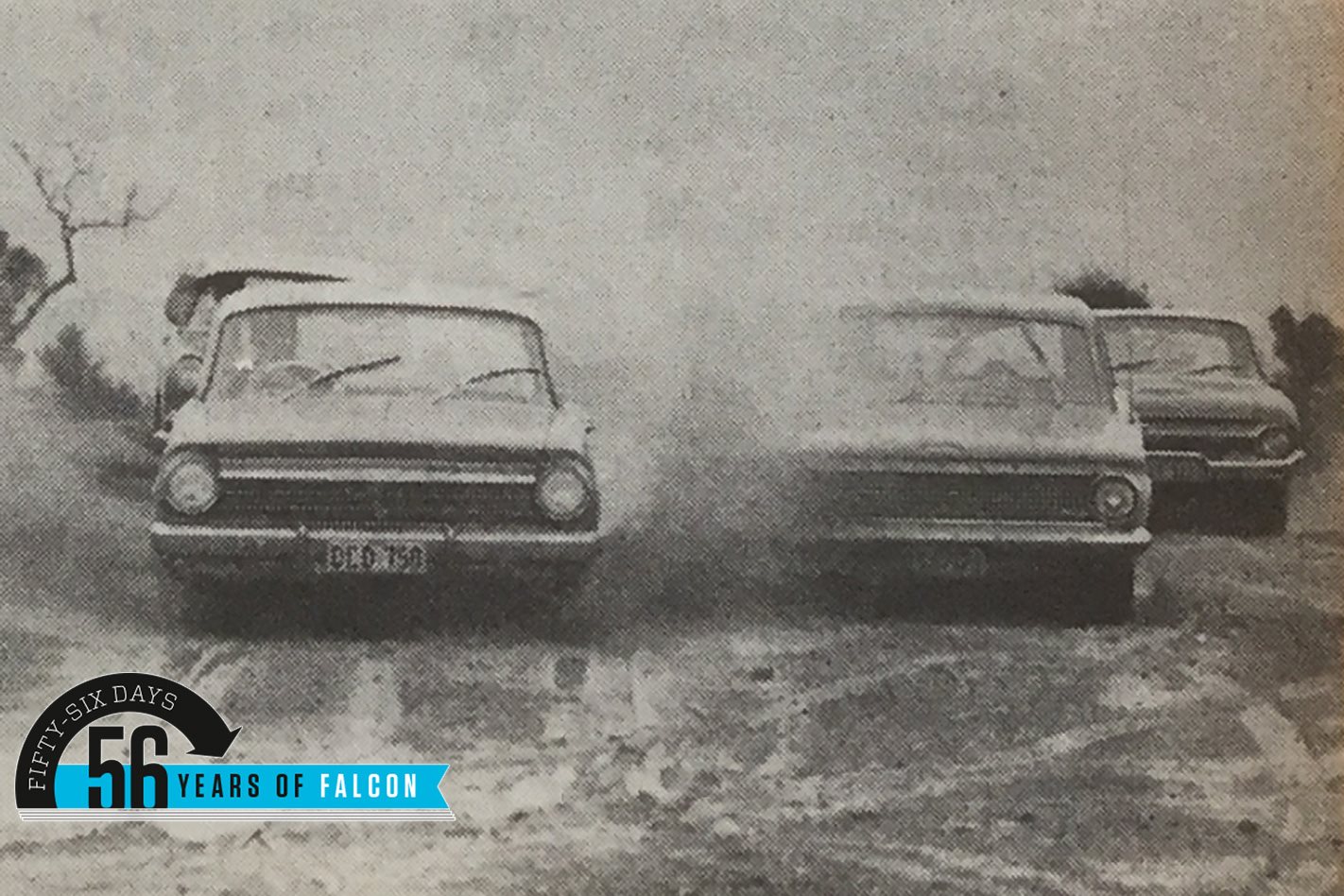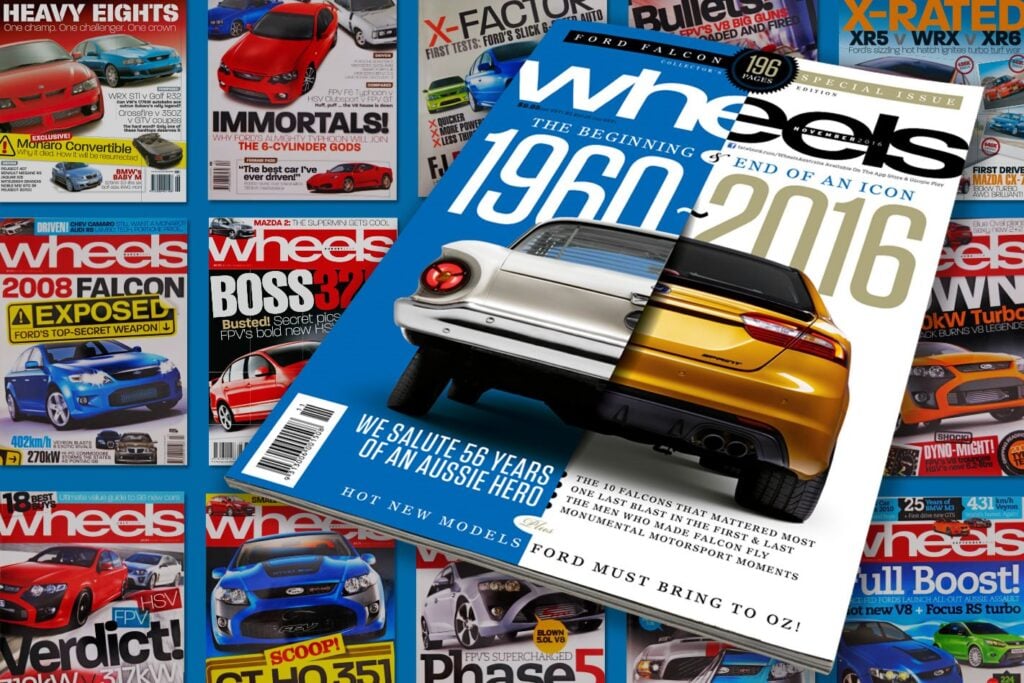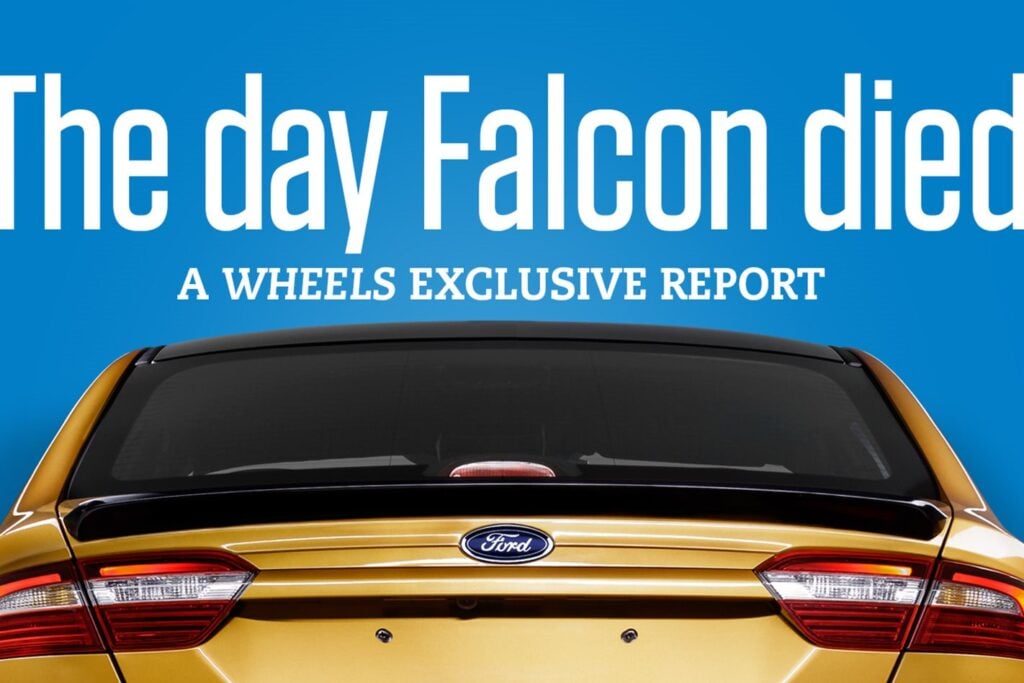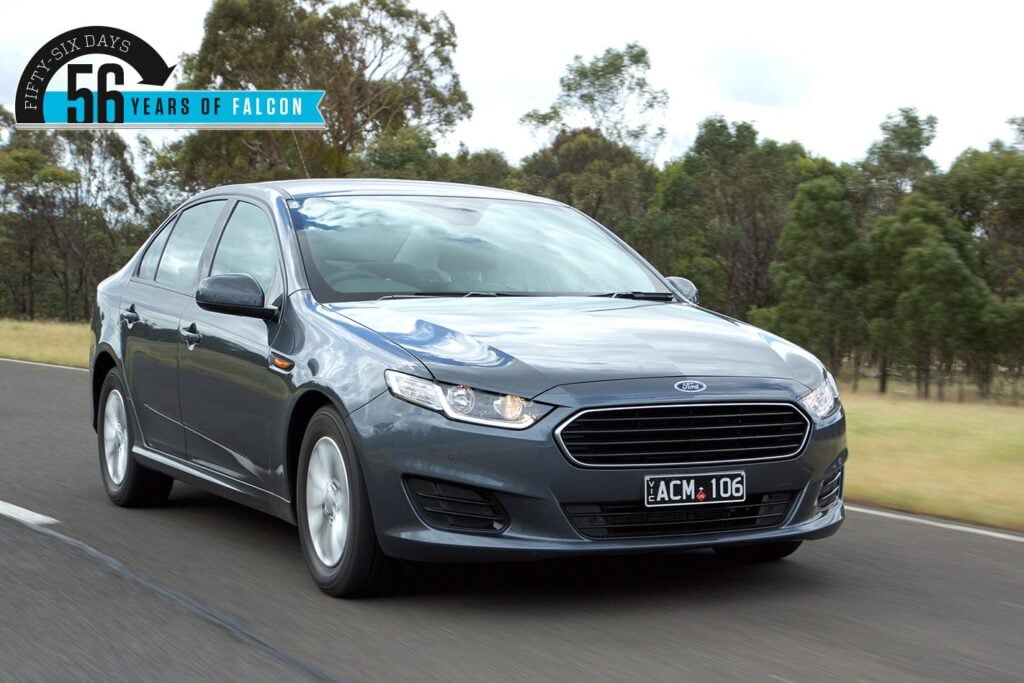I had an awful dream last night. I saw a Falcon on the Freeway and it was Holden its own with a Valiant.
First published in the November 1963 issue of Wheels magazine, Australia’s best car mag since 1953.
THE delicate art of one-upmanship has begun to bare its teeth. In Australian metropolitan newspapers in August were the echoes of clashing foils as the advertising men tangled over a roofline.
Ford’s “imitation is the sincerest form of flattery” was a slap on the wrist of GM-H for incorporating what has come to be called the “Thunderbird” roofline in its new EH series. True, the Ford essay in subtlety was a little less subtle than BMC’s teddibly understated and straight-faced reminder that an Austin was in Antarctica some jolly years before a Certain German Car even if the Austin had eight wheels, all equipped with chains.
That the Thunderbird roofline, best described as a squared rear quarter roof panel, is common to a number of cars is less design than accident. Its most immediate effect is to alleviate the problem of providing rear seat headroom under a generally lowering roofline, despite its dubious aesthetic value.
And by this time, the ardent student of affairs automotive will have realised that the Thunderbird roofline is used, in modified form, in the Valiant and the Austin Freeway as well.
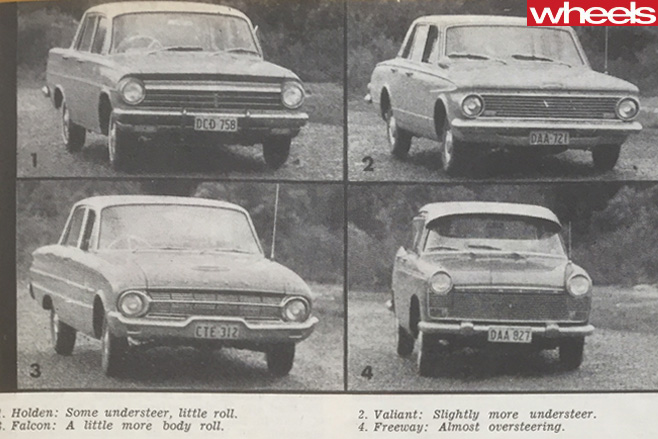
Thus a comparison of the four cars devolves into a careful analysis of minor points of difference, rather than a broad canvas of criticism. All four, for example use a six-cylinder, overhead-valve engine of between 2.4 and 3.7 litres, driving through a three-speed manual gearbox with synchromesh only on the top two gears. They are braked by drums of varying size, admittedly seat five comfortably, six uncomfortably and have similar luggage capacity.

The Holden is the cheapest, the Valiant the most expensive. The Ford Falcon is slightly cheaper than the Freeway, although many Ford dealers will only sell the Falcon shod with the larger 6.90 tyres, and this lifts the car’s price to a few pounds more than that of the Freeway. The Holden has the distinct advantage of having a long-established, complex network of distributorships and dealerships, as well as recognised used vehicle outlets and, in most capital cities, a thorough 24-hour-a-day spare parts service. It also enjoys slightly better trade-in prices, although lately the Valiant has been a force in the used car market in small numbers.
All four have luxury versions of the basic car, but only Holden and Falcon produce utility, panel van, and “standard” sedan units. Three also make station wagons, and the Valiant wagon is due shortly.
It is interesting to express the cars in terms of power-to-weight and weight-to-braking. The Holden has 22.2 lb per one bhp, the Valiant 18 5 Falcon 24 2 and Freeway 29.9 The Holden has 26.8 ib per square inch of brake lining area, Valiant 17.5 Falcon 21.4 and Freeway 16.5.
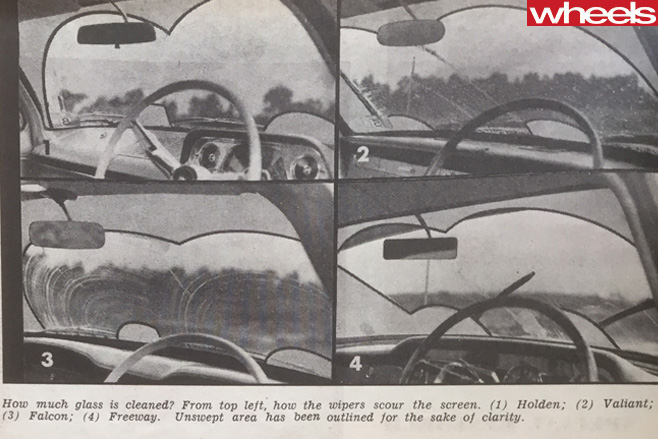
It should be stressed that the performance figures are those from particular cars, and where the margin is slight — as in the case of Holden and Valiant top speeds – it can be assumed that one is as rapid as the other. Additionally, several WHEELS staff have driven Pursuit-engined Falcons that put up better times than the test car.
So these were the cars: Holden automatic with 179 engine, Valiant automatic with its sole engine, Falcon automatic with 170 Pursuit, and Freeway automatic with the Blue Streak engine.
Although being released later than the Freeway, the Falcon’s basic design is the oldest of the four. It was the first US compact to appear, more than four years ago, and the XL model which appeared on the Australian market in August last year was less a facelift for the sake of a model change than a much tougher-engineered car. The Freeway suffers a little in that its narrower, shorter body on a shorter wheelbase was borrowed from the British B-series design for the A 60 and Morris Oxford. However, all four are now distinctively Australian, and are not produced in exactly the same form anywhere else in the world, even though Holdens and Falcons are exported from Australia to a number of countries.
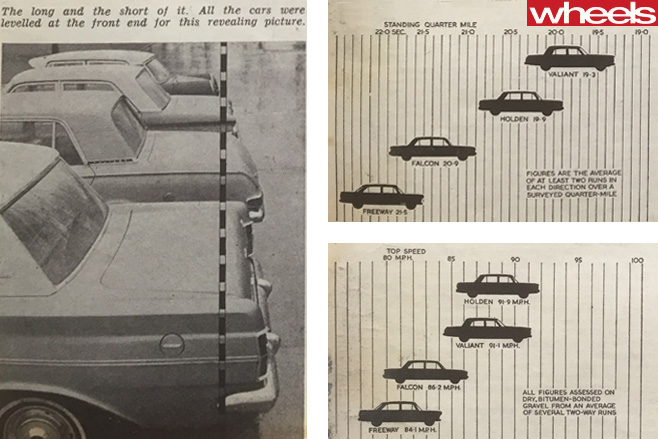
As the difference in fuel consumption by the four is minimal, it can be said that the Valiant’s much larger fuel tank gives the car a greater cruising range than the others and this is important in a country where fuel sources are scattered. It is also ahead in boot capacity — and those are the maker’s figures in each case – but has the least ground clearance.
The engines are probably the most individual characteristics of the four very similar cars. The new EH engine is oversquare, running on the highest compression ratio, with an immensely tough bottom end; a seven bearing crankshaft means long life not only because of its vibration-damping effect but because it will enable GM-H to modify it for extra power for some years ahead. Nonetheless, it is interesting that the Holden’s main bearing diameter of 2.1999 in is a little less than the Valiant’s diameter of 2.75 in. The Holden is the only engine with hydraulic valve lifters, and it has an alternator on offer as an option, where the Valiant’s is standard.

Ford have continued with both the 144 and 170 cubic inch engines in their 1964 Falcons in the US and this is enough recommendation for the unit.
Slightly oversquare, it is only just below the first two on power and torque, but it responds dramatically to a diet of 98-100 octane fuel. The BMC engine has an extra 7 ft/lb of torque for use with the Borg-Warner Type 35 automatic transmission, and while it is short on apparent power it is a very strong unit with first-class torque, or “lugging” ability, low down in all gears; indeed, in top gear the manual Freeway will out-haul the other three from 20mph to 40mph.

The Valiant has more brake lining area, commensurate with its greater weight. Of the four, the Freeway stops slightly better and fades less, although the Falcon and Valiant are almost as good. The Holden is markedly under-braked on three EH models that WHEELS tested the brake fade after one stop or an ordinary two-mile descent was quite alarming and GM-H should soon change this.
All four, unfortunately, suffer from wheel hop and rear axle wind up under “crash” braking; all left several sets of broken rubber marks on the road as evidence. This is a penalty common to the live rear axle. Pedal pressures are slightly higher on the Freeway.
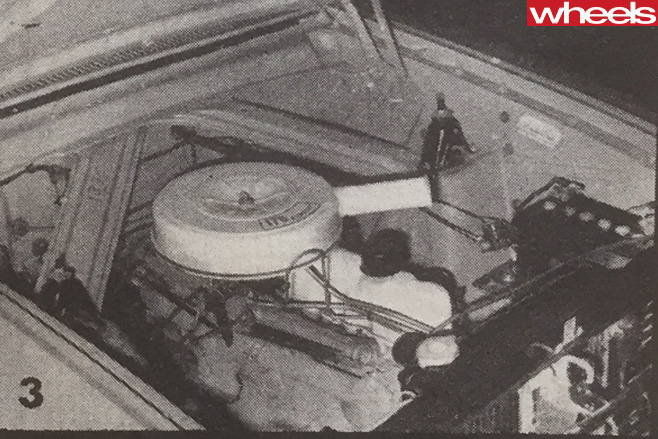
In other words, at normal speeds they tend to widen the arc of a corner, requiring more lock to keep them turning through the arc. Their main difference in handling characteristics comes through the varying types of steering.
All suffer to differing extents from axle tramp and wheel hop, due to the use of live rear axles. The Freeway will lift a rear wheel on a tight corner earlier than the other four, and too much power in a tight corner will also cause wheelspin in the Valiant.
Both Holden and Freeway steering is quite heavy at low speeds, lightening as the car gets faster, but both are more accurate at speed than the other two.
The Valiant steering is quite light, fairly positive, but with a little lost motion either side of top dead centre. The Falcon steering has been the most criticised of the four, not so much because of its low gearing but because the wheel is too close to the driver to enable him to make full use of his arms.
Driven hard, all are quite stable, although the Falcon steering makes one a little more cautious of loss of adhesion at the rear. The enthusiastic driver will probably respond more to the Valiant, particularly because of its excellent steering wheel location.
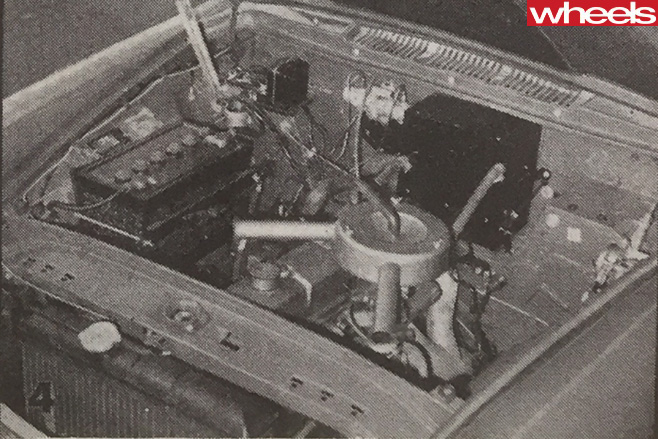
All four have good manual gearboxes. The Falcon has the longest lever throw, the Holden the shortest. None have synchromesh on first gear, although the Freeway’s first ratio is easy to engage at low speed because of the simple dog engagement; and most enthusiastic Holden drivers have long ago learnt to double the clutch to find first from 15 mph downwards.
Of the four, the Holden gear movement is smoothest and most positive, for both the Falcon and Freeway levers get a little “rubbery” in feel at times.
In automatics: The Holden uses the GM-H Hydramatic system, which uses fluid couplings instead of a torque converter for its three speeds. The Valiant has the three-speed Torqueflite unit, the Falcon the two-speed Fordomatic, and the Freeway the excellent British Borg-Warner Type 35 ….. all three use torque converters. The Valiant box makes the smoothest changes, although the Borg-Warner is faster. Both the Ford and Holden systems have a certain amount of built-in slip, which makes for extremely smooth operation, but does slow the changing process. Both the push-button Torqueflite and the lever-operated Borg-Warner respond to manual direction very well so that each car can be held in a desired gear right out to valve crash if necessary. The Holden and Ford systems arc less flexible, and will “hunt” from gear to gear on hills. All suffer from a small amount of idling creep in Drive range.
The Freeway is perceptibly the slowest car of the four, although it is certainly the most flexible in top-gear operation, an important feature in Australian markets. Nevertheless, it would be difficult to determine which car would win a point-to-point over varying surfaces and corners.
If the buyer of a six-cylinder car wants equipment, he goes to the Freeway. This is one of the hard facts of life with which the other three have to live. For BMC have followed the British line of making a car more liveable rather than adding performance.
Nowhere among the other three can the buyer get a heater/demister, windscreen washer, childproof locks, or a lockable fuel tank cap, except as an option. This difference shows up particularly in the Wolsely 24/80, BMC’s premier line.
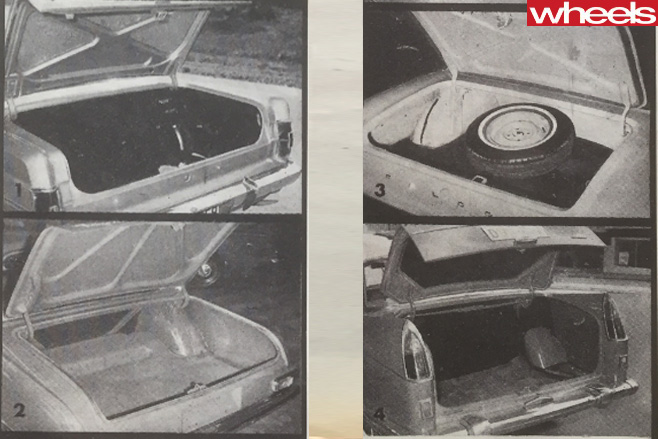
Measuring the four cars was particularly useful. It showed up shallow gloveboxes for what they are and also that the Valiant’s rear door aperture is narrower than those of the other three. The Freeway has much more leg room in the rear than the others, but at the expense of locating the driver too close to the big steering wheel. But the Freeway handbrake was in the right spot on the floor beside the driver’s right hand, where it can be reached even with safety belts on and where it can be used with greatest leverage. It was also the most effective.
The Falcon had insufficient front seat travel, but still more leg room in the r ear than the Valiant. Its lower boot lip was the highest off the ground, and it also had the most unfavorable spare wheel location. Here the Freeway does well by placing it in a wind-down tray under the boot.
However, there is a lot to be said for the system used in three of the cars of locking the doors by button as against the Freeway system of locking by interior door handles. Whether one likes the Holden system, peculiar to it of all the four, of locking the car without a key depends, we feel, on how forgetful one is.
None had notably low-geared window winding mechanism, although the Freeway was commendably fast while the Holden had the most rear seat headroom and the Falcon the best interior width.
In retrospect, the Holden, Valiant, Falcon and Freeway pretend to own little more than their inherent personality of honest, durable, unimaginative transport. As such, all four succeed, in different ways.
It is unfortunate that the volume buyer in Australia is denied the benefit of disc brakes, all-synchromesh gearboxes, and advanced suspensions, but this is perhaps because he is a victim of his continuing environment. Nevertheless, all four have achieved a measure of individuality, and it is this together with the price factor that will buy one of them for a man trusting his discrimination.
All are reasonably well finished, even though their trim runs to nothing more than pvc and woven fabric and rubber floor covering. The Holden is faintly superior, because of the company’s long experience in finish quality control, and both the Holden and the Freeway have sound reputations for body and paintwork standards. Neither will rust readily.
Valiant trim is neat, if a little plain, and the Falcon has improved on the poor standard of finish in the XK model. Also, the Valiant would seem to have the most usable boot space. All have good vision. But each car has its own disadvantages. The Valiant has adequate room in the rear seat, the Holden is underbraked, the Falcon has low-geared steering, and the Freeway amplifies road noise on certain surfaces. The Valiant reflects its dashboard lighting onto the screen at night, despite good rheostating, the Falcon screen collects bad reflections from the facia cowl in bright sunlight, the Freeway window winder is placed too far forward, and the horn buttons in the Holden are easily touched by accident.
The Valiant speedometer, while the sturdiest and most legible of them all, is so oddly calibrated to be difficult at speed, and the high beam light is obscured by the steering wheel boss. The Freeway could do with armrests on the front doors, and the Holden and Falcon should both have instruments replacing the warning lights, which can occasionally warn a little too late.
Tyre wear is not a factor for comment, because it varies considerably, depending on the driver, the maintenance of tyre pressure and front end alignments weather and road surfaces. Neither is any one of the four particularly more costly than its competitors for ordinary service jobs like lubrication. All are under 12 months or 12,000 miles warranty, whichever occurs first. Body repair costs are not greatly important for any of them, because none uses elaborate body panelling. There may be slight advantages in the BMC use of stainless steel, or the Valiant’s alloy grille. None is markedly noisier than its competitors, and all have a fairly firm ride over most surfaces.
So there it is. The difficult choice of the item which is probably every man’s most valuable single equity outside his house boils down to a number of quite small points, not the least of which is the trade-in offered for your old Slopmobile. You pays your money and you makes your choice.
Check out Wheels Archive online now for other great Ford Falcon features and more from decades past!
Simply log in here using your existing MagShop account or create a FREE account and select this article from the homepage.
Don’t have a MagShop account?

Have a MagShop account?


